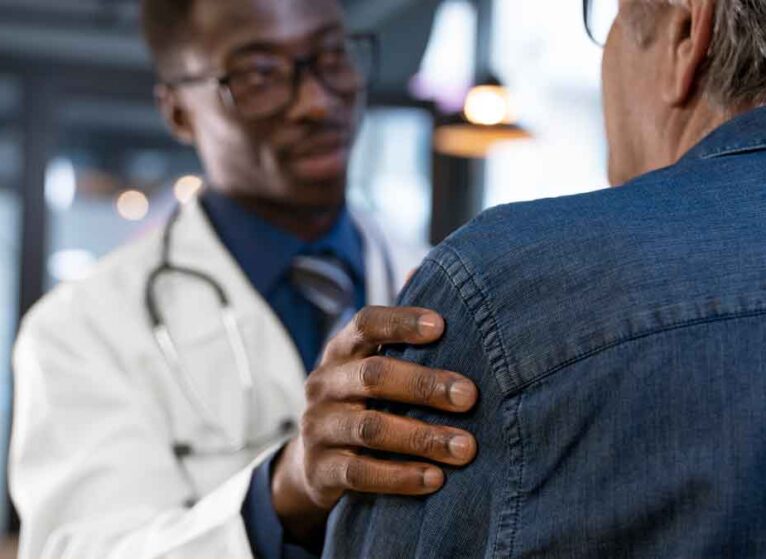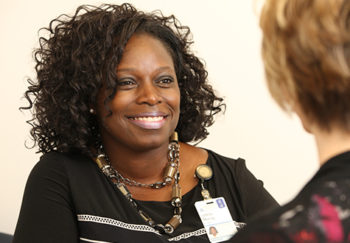Just the thought of cancer can make you feel anxious or uneasy, and sarcoma is no exception. Even so, when you’re in the know about sarcoma — or any type of cancer — it can help put your mind at ease.
Most people don’t know that sarcoma:
- It's different from other cancers
- It's rare, but there are 70 different types and subtypes
- Experts group sarcomas into two main categories — soft-tissue sarcoma and bone sarcoma
- Some grow fast, while others grow slowly
Sarcoma tumors can start deep inside your body, and the tumors may be painless, so early symptoms aren’t always easy to spot.
Read on so you’ll know what sarcoma is and what to do if you might have it. If you have or suspect cancer, the UVA Cancer Center experts and sarcoma-savvy specialists at UVA Health are here for you.
Sarcoma 101
What is sarcoma? If it’s new to you, you’re not alone. Sarcoma is an umbrella term for a group of cancers that can grow in connective tissues in your bones, fat, muscle, and cartilage. It’s relatively rare: In the U.S., only about 1% of adult cancers diagnosed each year are sarcomas. In children and teens, sarcomas make up about 15% of cancer diagnoses.
Soft-tissue sarcomas can start in your blood vessels, fat, nerves, muscles, and tendons — the fibrous tissues that connect your muscles to your bones. Sarcomas may develop in deep tissues almost anywhere in the body, like the lining of the stomach or uterus.
Bone sarcomas often start in fast-growing bones in children. However, they can develop in other bones in children and adults.
At UVA Health, sarcoma specialists are regional leaders in studying and treating sarcomas. Their work includes clinical trials to develop and test the effectiveness of new therapies. Multispecialty teams offer some of the newest and most effective treatment options for this challenging, but treatable, form of cancer.
Things that Could Raise Your Risk of Sarcoma
Experts haven’t found one clear cause of soft-tissue or bone sarcomas. According to the American Cancer Society, potential risk factors for developing sarcoma include:
- Chemical exposures. A high exposure to certain chemicals can raise your risk of specific types of sarcoma. Potential chemical risk factors include:
- Vinyl chloride (used in plastics)
- Arsenic
- Dioxin (industrial waste)
- Radiation exposure. Sarcomas sometimes develop as long as 10 years after repeated doses of radiation. This can include radiation therapy for breast cancer or other types of cancer. However, modern radiation therapies are more targeted and precise, which helps limit overall radiation exposure.
- Inherited genetic risks. Certain types of cancer and cancer risk factors may run in your family. A family history of sarcoma or certain genes can raise your risk. If you have these or other genetic conditions, or a family history of these conditions, you may have a higher risk of sarcoma:
- Lymph system disorders. Your lymph nodes carry clear lymph fluids throughout your body to help fight off disease. If your lymph nodes have been removed or damaged by radiation or other injuries, lymph fluid can build up and cause swelling (lymphedema). Over time, this can increase your risk of disease, including sarcoma.
Sarcoma Cancers Can Be Sneaky
Signs of sarcoma can be silent or subtle at first. Symptoms depend on where the tumor is located and whether it’s a soft-tissue sarcoma or bone sarcoma.
Some sarcomas start deep inside connective tissues, like in the lining of the stomach or uterus. Others can make it look as if one muscle on an arm or leg is a little bigger than the muscle on the other side.
Depending on the type and location of a tumor, you might not notice it until it grows larger or presses against nearby nerves, organs, and tissues. It's never too early to ask your care provider about out-of-the-ordinary symptoms or a lump, especially if it starts to get larger.
Don’t Dismiss Early Warning Signs
Don’t delay asking your provider about these or other unusual changes:
- Abdominal swelling or discomfort
- Abnormal vaginal bleeding
- Belly pain or vomiting
- Constipation
- Coughing or breathlessness
- Fragile bones that break easily
- Growing waistline that’s unrelated to overeating or dietary changes
- Lump in any part of your body
- One arm or leg muscle is larger than the other
- Pain in your abdomen, pelvis, trunk, or back
- Pain or swelling that makes it difficult to move a joint
- Persistent bone pain anywhere in your body
- Swelling in an arm, leg, or other parts of your body
What to Do if You Suspect Sarcoma
Sarcoma is a scary disease, but it’s treatable when you have the right specialists to guide you. Ask your provider right away about any unusual signs and symptoms. Early diagnosis and treatment help make this condition more manageable.
If a biopsy (looking at a tissue sample under a microscope) confirms sarcoma, your UVA Health care team will walk you through the latest treatment options and other details. Treatment typically includes surgery to remove the tumor and other therapies, like radiation and chemotherapy.
At UVA Health, you’ll also have access to the latest innovations, including stem cell therapies and advanced procedures to evaluate and treat sarcoma. A multispecialty sarcoma tumor board provides ongoing guidance specific to your individual condition and care needs.
When you know what to do and who can help, you’ll have all the answers you need. Simply request an appointment and breathe a sigh of relief. Your health is in good hands.


